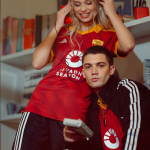
The Making of an icon: Germany's shirt for Italia '90
In Russia adidas is betting on Nostalgia, and Germany's shirt is the benchmark for it
June 5th, 2018
It was 1984 when Ina Franzmann started working with adidas as an assistant designer. She got into this industry thanks to her grandfather's job: he was a tailor for men, and Franzmann acquainted herself with fabrics, embroidery and men-oriented patterns from the early age. After the studies at the German Fashion University and a couple of months in the women's fashion, she had been hired by the German brand. These are the first golden years for the design of soccer jerseys, and the upcoming EURO 1988 was the ideal stage to show off their creations. One of these is the home kit of West Germany. It has a symbolic power so pronounced as to mark a breaking point with the previous uniforms of the Mannschaft with a minimalist and essential look, entirely white with black decorations on the collar and the sleeves. The shirt's sharp fantasy with the colors of the German flag becomes an icon. Lately this adjective is abused, but in this case, it fits perfectly: that shirt embodies the historic moment of Germany and the mainstream '90s aesthetic that was taking over the world.

Few reasons make this shirt historic
It is a stylistic and costume masterpiece never seen before, born from the mind of Franzmann and designed entirely by hand. The most obvious aspect is the geometric design aimed at accentuating the shoulders and pushing up, meant as an allegory of victory. The uniform is so appreciated that two years later it is replicated at the 1990 World Cup hosted by Italy – it seems it was a Franz Anton Beckenbauer’s idea – where the final sanctification takes place. The West German shirt becomes an icon and enters the collective imagination as the most beautiful ever worn by the National team.
There are at least three reasons to explain this achievement: in addition to purely aesthetic beauty and the successful experimentation of new languages whose geometrical shapes seem to recall those of the mascotte Ciao!, the team win out and the images of his party players are broadcasted on all the televisions and fill up all the newspapers’ front pages. There is an historical motivation as well: Italy 1990 World Cup is in fact the last tournament before the reunification under a single National of the two German federations (the East side failed to qualify on that occasion), held in a period in which adidas cyclically churn out their best uniforms, becoming sportswear influencers in the coming years. That of Holland for Euro '88 and Manchester United (1983-84 season) belong to this successful production season; none, however, is able to match the German counterpart by visual impact and symbolic power.
Reimagining the Icon: the 2018 Germany kit
28 years later from that successful journey, Germany has chosen the revival of the home kit of Italia '90. The kit manufacturer remains adidas – having relied the partnership agreement until 2022 – while the jersey has been updated: there is no longer the German flag, took over by a black and white fantasy with a series of lines from different thicknesses to create the graphics’ body, this time higher than that of Italia '90. The restyling implemented for Russia2018 responds to the stylistic needs of the present and to the courage of adidas to give life to continuous references between sportswear and streetwear, in a climax of twists able to attract both the young consumer fanatic lifestyle and the more retro customer.
The uniform is a mix of refinement and simplicity, a perfect meeting point between the trend of adidas in the 80s and 90s to explore new horizons and the desire not to upset what has always been the basis of the German kit: a clean shirt without over-the-top outputs, worn and made famous even outside of football environments. This is the case of Paul Kalkbrenner, one of the most important and known electronic music producers, who performed at Tomorrowland 2016 wearing the Germany kit of Italia '90.
The adidas' Nostalgia strategy
The fascination with nostalgia for the golden age of football shirts alone is not enough to explain such a success. Looking at the past means selling to the consumer an emotion to which it is linked, but to make the operation effective it is necessary to update the product. In the case of Germany, this need has turned into the substitution of the colors of the national flag, a bold move as was their introduction into the 1988 previous uniform.

Adidas has therefore exploited the attraction for the past and the need to adapt it to the contemporary by redesigning almost all the uniforms inspired by the past: of all those designed for the World by the German brand, in fact, only the kit of Japan has remained exempt from the nostalgic wave. A tendency of this kind is a bit like the litmus test of adidas' conservative approach, in stark contrast to Nike's futuristic and innovation, arisen with Nigeria's "For Naija" collection. Re-evoking the nostalgic aesthetic taste guarantees a greater audience – triggered by the union of new and old enthusiasts, who are fond of past-oriented products but inevitably risks causing uncomfortable comparisons with current aesthetic and technological canons. Therefore, it is necessary to be creative, an assumption that adidas has used redefining in a modern key a cult of sportswear of the Nineties – the same happened with Stan Smith, re-launched in 2014 after the success of the beginnings of more than forty years before.
The German brand has not so disappointed the expectations, unraveling between past and present to conceive another wonder, perhaps its best creation designed for Russia’s World Cup. Germany is going to take part as the reigning champion with an encouraging omen: the last time they wore this jersey, we all know how it ended.
























